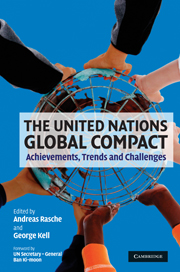Book contents
- Frontmatter
- Contents
- List of figures
- List of tables
- List of boxes
- List of abbreviations
- List of contributors
- Acknowledgements
- Foreword
- Why This Book Matters!
- The Ten Principles of the United Nations Global Compact
- 1 Introduction: the United Nations Global Compact – retrospect and prospect
- Part I Achievements, trends and challenges: reflections on the Principles
- 2 Making sense of the United Nations Global Compact human rights principles
- 3 The promise of the United Nations Global Compact: a trade union perspective on the labour principles
- 4 The United Nations Global Compact Environmental Principles: achievements, trends and challenges
- 5 ‘Caring for Climate’: the Business Leadership Platform
- 6 Anti-corruption: challenges and trends
- Part II Participants and engagement mechanisms
- Part III Governance and Communication on Progress
- Part IV Local Networks: the emerging global–local link
- Glossary
- Bibliography
- Index
2 - Making sense of the United Nations Global Compact human rights principles
Published online by Cambridge University Press: 05 February 2012
- Frontmatter
- Contents
- List of figures
- List of tables
- List of boxes
- List of abbreviations
- List of contributors
- Acknowledgements
- Foreword
- Why This Book Matters!
- The Ten Principles of the United Nations Global Compact
- 1 Introduction: the United Nations Global Compact – retrospect and prospect
- Part I Achievements, trends and challenges: reflections on the Principles
- 2 Making sense of the United Nations Global Compact human rights principles
- 3 The promise of the United Nations Global Compact: a trade union perspective on the labour principles
- 4 The United Nations Global Compact Environmental Principles: achievements, trends and challenges
- 5 ‘Caring for Climate’: the Business Leadership Platform
- 6 Anti-corruption: challenges and trends
- Part II Participants and engagement mechanisms
- Part III Governance and Communication on Progress
- Part IV Local Networks: the emerging global–local link
- Glossary
- Bibliography
- Index
Summary
Introduction
The ten years in which the United Nations Global Compact has been in existence have been watershed years with respect to business and human rights. Never before has as much attention been paid to the many ways that businesses impact human rights conditions, and it is safe to say that the Global Compact is one of the main reasons why this is so. Specifically, more companies have pledged their support for human rights than ever before, and the Compact is perhaps the single greatest catalyst for these commitments. In addition, the Compact has reminded businesses and stakeholders that human rights principles are indeed universal, and not merely the product of Western or wealthy nations. Finally, the Compact has provided a unique and essential platform for dialogue, enabling business, government, civil society and trade unions to discuss, debate and create progress.
At the same time, the link between business and human rights remains unclear for many. At the policy level, there are questions about the relationship between public and private responsibilities, as well as whether and how well national accountability systems fit with globalized business activities. And at a practical level, many business people continue to grapple with the precise meaning of human rights as they relate to daily commercial activities. This chapter traces the development of human rights as a business matter; the impact of the Global Compact, the Special Representative's mandate; practical applications of human rights by business; and, finally, a look ahead at what the future may hold.
- Type
- Chapter
- Information
- The United Nations Global CompactAchievements, Trends and Challenges, pp. 23 - 43Publisher: Cambridge University PressPrint publication year: 2010
- 1
- Cited by



